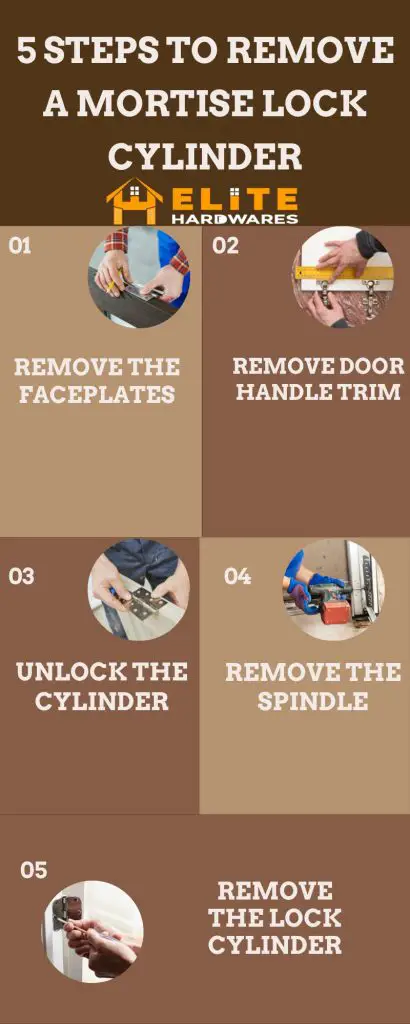How to Remove a Mortise Lock Cylinder? | 5 Easy and Reliable Steps
Mortise cylinder locks are most typically seen in older residences and commercial applications. Even if there are several variants, the core principles remain the same. So How to Remove a Mortise Lock Cylinder or How do you remove old mortise locks?

The cylinder of a mortise lock is screwed into the lock body. Rekeying or replacing your lock’s cylinder is an option if you have misplaced your original one.
You simply need screwdrivers to remove lock cylinders. Entry door cylindrical locks are internal-keyed. They use an internal lock that connects with the door trim by inserting and withdrawing a bar using a key or handle.
Mortise Locks Cylinder
Mortise locks are widespread yet challenging to alter. As a result of the vast variances in the cylindrical lock. Cylinders are manufactured by various manufacturers and even within the same manufacturer’s product ranges. You cannot buy a new cylinder if you do not know the lock’s brand and model.

If you do not have a spare cylinder, you must keep the seat open while you purchase one or have the present one rekeyed. Try to have someone monitor.
Key-in-knob locks are cylindrical. The brand name is generally on the cylindrical lock’s latch face. Remove the knob or lever to access the cylinder. You will need a strong wire and the lock’s key.
No poke hole suggests your lock is cheap, old, or difficult to remove. You should replace the lock.
You may remove the outer knob or lever by inserting the key and turning it 90 degrees. Insert a wire or complicated item through the poke hole with the key at 90 degrees. A pin under the poke hole must be depressed to remove the lever or knob.
To remove a knob or lever, pull it while pressing the pin in the poke hole and twisting the key 90 degrees. It should move quickly. It would be easier with three hands.
Afterward, inspect the inside from the backside. There should be some kind of plastic or metal holding the cylinder inside the knob or lever.
Product Recommendation
Are you looking for the best screwdriver to remove the mortise lock cylinders? Amartisan 10-Piece Magnetic Screwdrivers Set can help you.
How to Remove a Mortise Cylinder Lock

1. Remove the Faceplates
Remove screws from a stand-alone lock cylinder without a door knob. Locate the screws on the door’s inside cover plate using a flathead or Phillips head screwdriver.
Twist it to release the lock’s cover. If you loosen the top screws first, the faceplate may rotate down, making it difficult to remove the lower ones.
2. Remove Door Handle Trim
Unscrew door handle trim from the base. Remove the knob’s screws. If the handle-and-lock combination is locked on, pop off the trim to expose the screws keeping the door handle in place.
3. Unlock the Cylinder
Insert a screwdriver into the lock cylinder’s spindle. Turn the screwdriver counterclockwise to unlock. This aligns the cylinder’s square tab with the housing’s square notch, releasing the lock.
4. Remove the Spindle
Find the spindle’s spring-loaded tab. To remove the spindle from the housing, depress or gently pry it up.
5. Remove the Lock Cylinder
Flathead screwdriver into spindle housing hole. Insert a flathead screwdriver beneath the lock cylinder’s tabs. Apply slight pressure to the tabs and push into the spindle hole to remove the internal cylinder.
You may simply press straight into the middle of the spindle housing to remove the lock cylinder without bothering about the tabs. If you can not see the pressure tabs, push carefully and softly until the lock cylinder pops out the other side.
After removing the doorway trim and door handle, lock cylinders can be pulled out similarly.
Frequently Asked Questions
1. How Do You Remove a Lock Cylinder From a Door Knob?
Step 1: Unscrew the front lock
Locate the lock position first. Once there, find the keyhole. Escutcheon plates secure the lock body. It contains two screws in the top and lower metal. Unscrew and remove the lock body.
Step 2: Remove the lock’s screw
The door’s locking screw is inside. It retains the euro-cylinder lock, so it is easy to find.
Unscrew the locking screw, but do not remove the faceplate nuts.
Step 3: Turn the cam to 12 o’clock
Turn the cam to 12 o’clock. Without a key, use a straightened paper clip. Place it on the right side of the lock above the cylinder cam. Press the cylinder cam into the lock.
Step 4: Remove the door lock
Once you have done the preceding, expel the lock from the door cavity. Old locks are simple to replace. If the lock is new and you are new to this technique, it may take many tries.
Final Words
If someone asks you How to Remove a Mortise Lock Cylinder or how to remove Corbin mortise lock, you have the answers.
Whatever can be applied with tools can be removed with instruments. Good locks just delay down burglars. Burglars want to be quick. They may give up or try another door if you make it tough.





